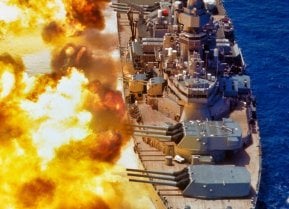Japan Might Build 'Super' Destroyers. Why? Think North Korea and China.
Tokyo is now considering the feasibility of procuring two "super-destroyers."
The Japan Maritime Self-Defense Force increasingly resembles the former Imperial Japanese Navy, but in a smaller size. It has a fleet of some 154 ships and operates 346 aircraft. In 2000 it has also been the world's fourth-largest navy by tonnage, and likely will only increase in size.
In December 2018, Tokyo approved a plan to modify its two Izumo-class helicopter carriers to embark the Lockheed Martin F-35B Lightning II jet fighter. The modifications would enable Japan to operate flattops with fixed-wing aircraft for the first time since World War II. The Japanese government also announced as part of its record-setting defense budget it would purchase additional F-35 aircraft.
With an eventual plan to be equipped with 105 F-35As and 42 F-35Bs, Japan would become the largest operator of the fifth-generation stealth fighter aircraft outside of the United States.
Not Battleships But The Next Best Thing
One type of warship the Japan Maritime Self-Defense Force won't operate is a battleship, and there are no plans for a 21st-century version of the Yamato super battleship.
However, according to a recent report from TheDrive, citing Japanese media, Tokyo is now considering the feasibility of procuring two "super-destroyers." Such warships – much like the modified flattops – would seem to be in contradiction of Japan's 1947 Constitution, which renounced war, but is also seen to suggest that Japan's military forces are maintained for the purpose of self-defense.
In this case, however, the super-destroyers would serve as a replacement to the pair of planned land-based Aegis Ashore systems. Work on those was suspended due to technical issues, costs and domestic criticism. The destroyers would be focused on missile defense – primarily from North Korea – and would be equipped with a version of the Aegis combat system that is equipped with Lockheed Martin's AN/SPY-7 Long Range Discrimination Radar. That platform was originally intended for the shore-based Aegis system.
Nikkei Asia reported that the funding for the system modifications of the AN/SPY-7 will be allocated in Japan's fiscal 2021 budget.
While the Defense Ministry has been expected to approve the vessels, based on an interim report that is due later this month from a private-sector technical study, officials have also considered the option of a special-purpose warship that could be dedicated to intercepting missiles. However, despite the fact that such a vessel would cost less, it could be far more vulnerable to submarine and air attacks.
The other consideration is that even as North Korean missiles are seen as the primary threat, Japan has other priorities that include patrolling the East China Sea due to increased Chinese aggression, and new Aegis-equipped destroyers could be a practical addition to the fleet due to their maneuverability and defenses.
One issue outstanding could be that of personnel. Tokyo opted for the Aegis Ashore system to address the lack of personnel, but now the Maritime SDF may need to be further expanded with the addition of such warships.
A New Class
Yet to come into focus is whether Tokyo would opt to build a new warship or a derivative of vessels currently in the fleet. TheDrive cited a report from Tokyo's Kyodo News agency, which suggested that the government was considering a vessel with a standard displacement of around 8,000 tons – which would be larger than the current Maya-class's displacement of 8,200 tons.
The Maya-class is a modified version of the Atago-class, and the lead vessel Maya was commissioned on March 19, 2020, with a second vessel, Haguro, set to enter service in March of next year. These vessels were also designed to enhance Japan's ballistic missile defense capabilities, but now it seems that Tokyo is thinking even bigger.
Peter Suciu is a Michigan-based writer who has contributed to more than four dozen magazines, newspapers and websites. He is the author of several books on military headgear including A Gallery of Military Headdress, which is available on Amazon.com.


